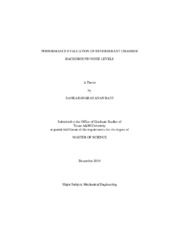| dc.description.abstract | An improved test system for acoustical rating of air-movement devices was installed
and evaluated at the Riverside Energy Efficiency Laboratory at Texas A&M University
where measurements of sound pressure levels were carried out using an array of six microphones
instead of the existing rotating boom- microphone setup. The new array
setup did not generate any inherent transient noise peaks, which provided adequate
signal-to-noise ratios suitable for low sone fan testing.
The reverberation chamber was qualified for broad-band testing in the frequency
range 50 Hz to 10 kHz. Important acoustical parameters, namely, reverberation time and
natural modes of the chamber, were determined.
The purpose of this study was to identify potential background noise sources by
computing the coherence functions between microphones placed outside the chamber
and a microphone placed within the chamber. No strong coherence was observed, thus
indicating adequate sound attenuation characteristics of the chamber walls.
The effect of background noise levels on the loudness rating of fans was evaluated.
A low sone fan and a louder fan (loudness greater than one sone) were tested during night time when the background noise is the least and during daytime and with the air
conditioners running (high background noise level). While both fan types showed no
significant change in loudness when tested during daytime and during the night, accurate
ratings were not obtained with the air-conditioners running due to inconsistent spectrum.
Finally, it was observed that with the six decibels separation requirement between
the fan and background noise spectra for a low sone fan, at very low frequencies (below
63 Hz), despite inadequate fan- background separation, the loudness rating of the fan
does not change as the minimum perceived loudness at these frequencies is very high. At
very high frequencies (greater than 5 kHz), the fan does not generate any noise and
hence the fan and the background noise sound pressure levels are very close to each
other. | en |


